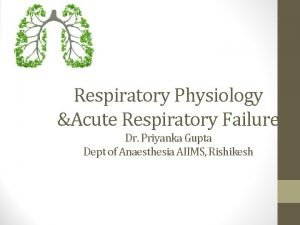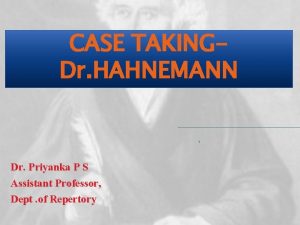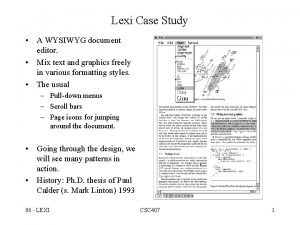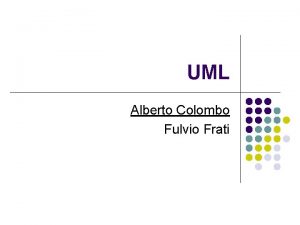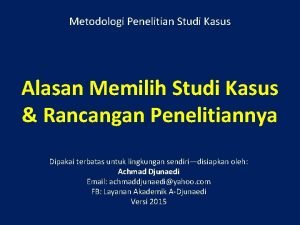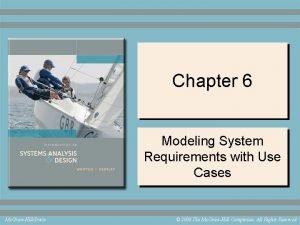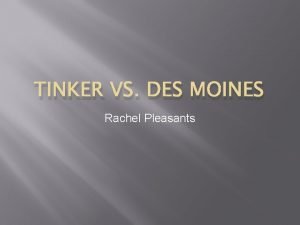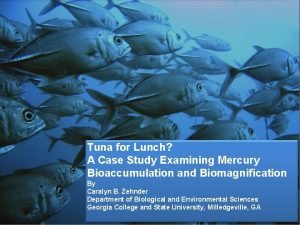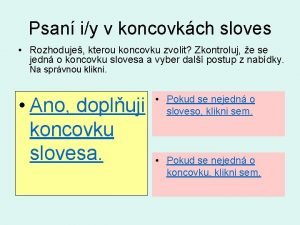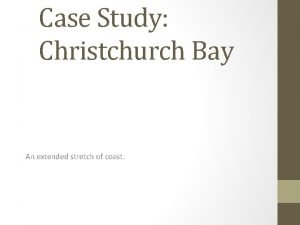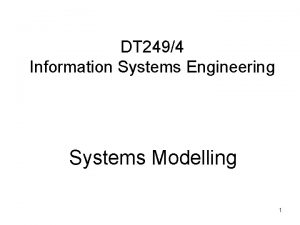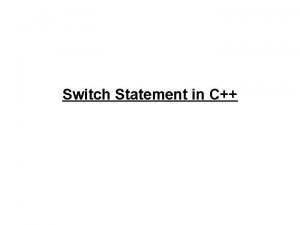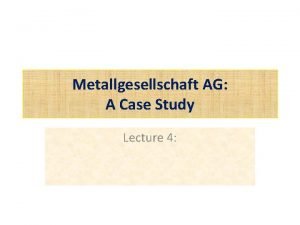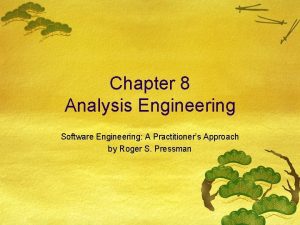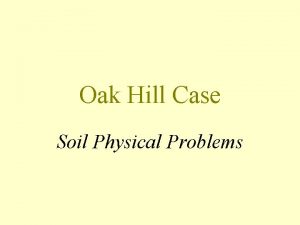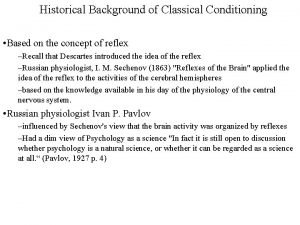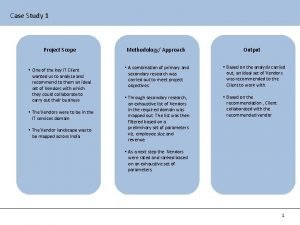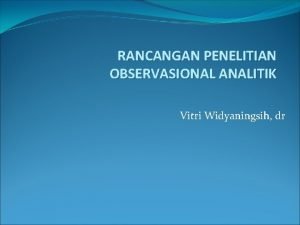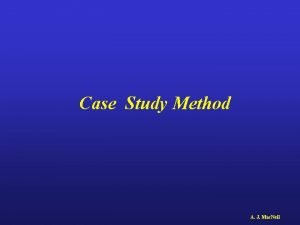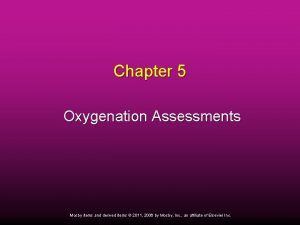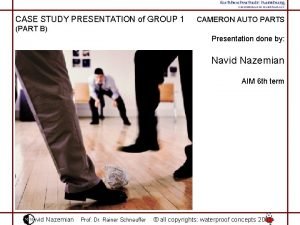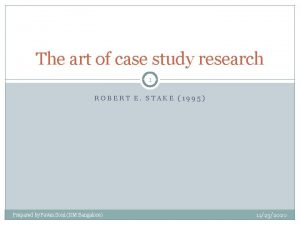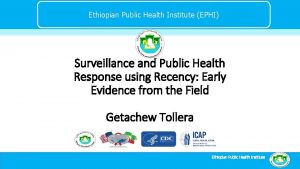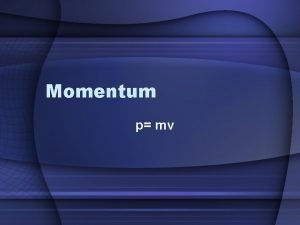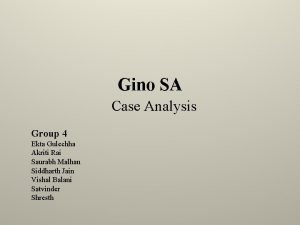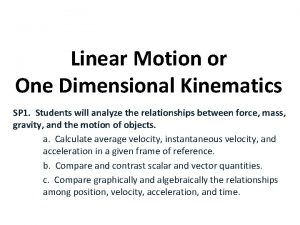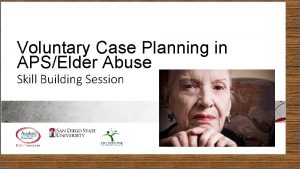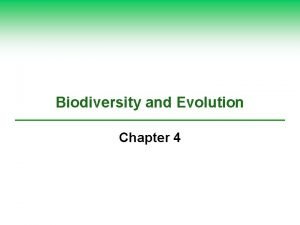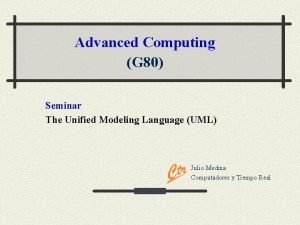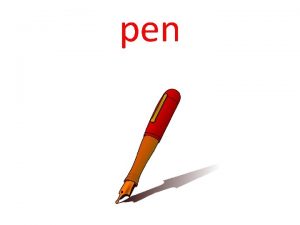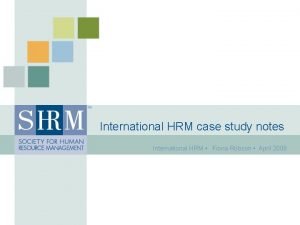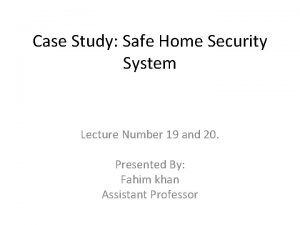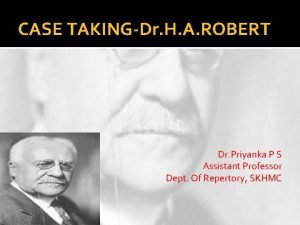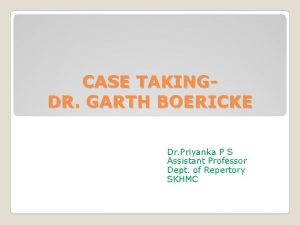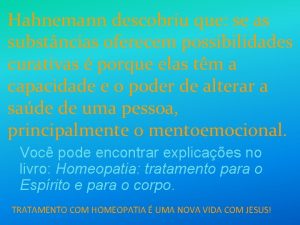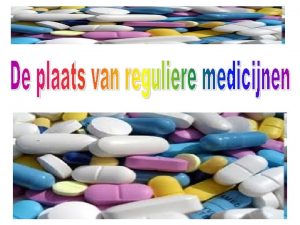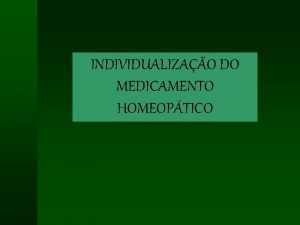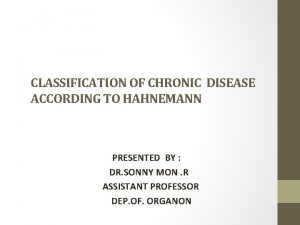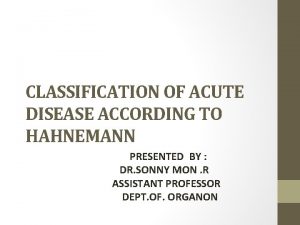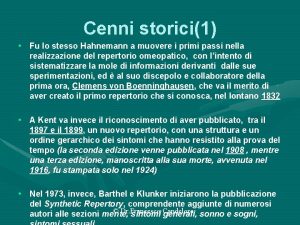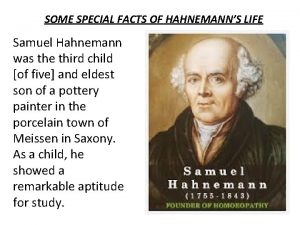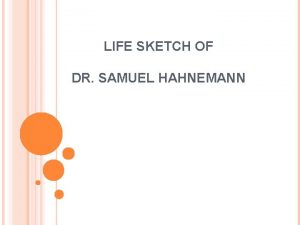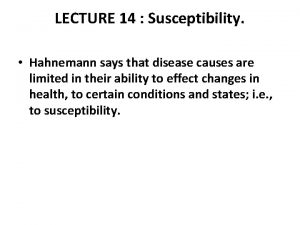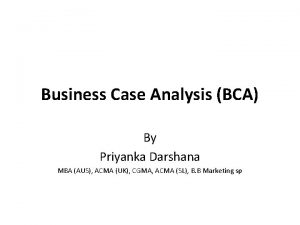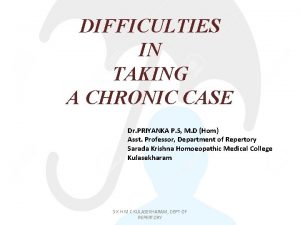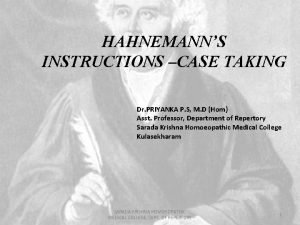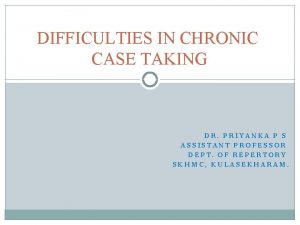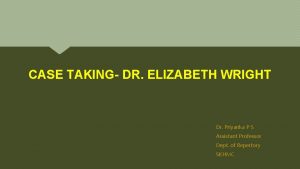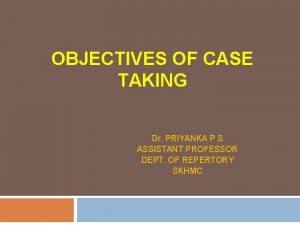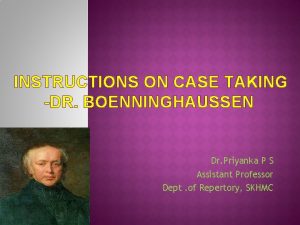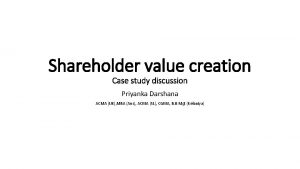CASE TAKINGDr HAHNEMANN o Dr Priyanka P S






































































- Slides: 70

CASE TAKINGDr. HAHNEMANN o Dr. Priyanka P S Assistant Professor, Dept. of Repertory

Definition : �CASE TAKING is a unique art of getting into conversation , observation and collecting information from patient as well as from by standers to define the patient as a person and diagnose the disease.

� Primary object of Case taking is the collection of data, for a prescription on the basis of Homoeopathic Philosophy. � The case taking for Homoeopathic management requires background knowledge of various disciplines like ---Principles of Homoeopathy ---Basic Medical Science ---Clinical Subjects ---Communication skills

Dr. Samuel Hahnemann was the first person to realise that the whole man is sick and not the organ. H e advocated the HOLISTIC APPROACH while treating a person who is sick.

In MEDICINE OF EXPERIENCE (1805) , and in ORGANON OF MEDICINE he has described the method of investigation of a sick man.

SOURCES OF INFORMATION � The Patient � Bystanders � Physician’s Observation

HAHNEMANNIAN INSTRUCTIONS AN OVERVIEW ON APHORISMS

Aph No. SIGNIFICANCE OF APHORISM $ 83 Physician’s Special Qualifications $ 84 Expression of patient and imp. parts recording $ 85 Fresh line-separately arranged $ 86 More Information $ 87 No suggestive questions $ 88 Questions of parts not detailed & mental sym $ 89 More special questions $ 90 Observations and ascertains $ 91 If it is a slow case $ 92 If it be of rapid course $ 93 It be by some obvious cause

Aph No. SIGNIFICANCE OF APHORISM $ 94 General Directions $ 95 Lesser Accessory symptoms $ 96 Hypochondriac Patients $ 97 Indolent Patients $ 98 Attach credence $ 99 Individual disease $ 100 Consideration as an unknown one $ 101 Characteristic portrait to be obtained $ 102 Abstracts ascertained from several patients $ 103 Psora must be investigated $ 104 Picture of the disease and recording

HAHNEMANNIAN SCHEME General directions on case taking 83 -93 Chronic Cases 94 -98 Acute Cases 99 -102 Next Duty of Physician 103 -104

§ 83 § Individualizing examination of a case of disease § GENERAL DIRECTIONS § the practitioner will bear in mind only what is applicable for each individual case

QUALITIES OF PHYSICIAN �DEMANDS OF THE PHYSICIAN �freedom from prejudice and �sound senses �attention in observing and �fidelity in tracing the picture of the disease.

§ 8 4 § Detailed history of sufferings of the patient § By standers tell what they heard him complain of, how he has behaved & what they have noticed in him § Physician sees, hears and remarks by his senses altered or unusual character in patient.

§ He writes down details accurately in very expressions used by them. § The aphorism foot note deals with the cautions against the disruption of the patients train of narration §Should not interfere patients unless they to other matters. wander off

§ 85 § He begins a fresh line with every new circumstance mentioned by patient or his friends. § He can thus add to anyone , that may at first have been related in too vague manner, but subsequently more explicitly explained. § Says that every new expression made by the patient or attended has to be entered in a fresh line. § This may help to complete the data’s later and prevent confusion about the discrimination of symptoms

The process of writing down symptom during case taking Ø The symptoms should be written in 3 steps (84 -85) 1. Patient’s reports 2. Attendant’s reports 3. Physician’s observations

§ 86 �Narrate the manner in which the incomplete information can be made complete �When the narrators have finished saying his symptoms , physician reverts to each particular symptoms and elicit more precise information �for e. g. , at what period did this symptom occur? �Was it previous to taking the medicine or whilst taking med �Kind of pain, spot; modalities etc

More precise information For having more precise information in case taking, the physician reads over the symptoms as they were related to him, one by one, and about each of them, he enquires for further particulars as follows 1. Location 5. concomitants 2. Sensation 6. Duration 3. Complaints 7. Causation 4. Modalities 8. Extensions 9. Time of occurrence

§ 87 �Cautious about the don’t’s in case taking �Avoid LEADING QUESTIONS ie. , questions which suggest answer to patient, so that he shall only has to answer yes or no. �Else he will be misled to answer in positive or negative something untrue, half true or not correct, either from indolence or to please the interrogator. Leading to false picture of disease.

No suggestive questions � � � � The physician must not frame his questions so as to suggest the answer to the patient If the physician asks suggestive questions, the answer will be in most cases “Yes” or “No”. This will: Mislead to answer in affirmative or negative These will be something untrue These will be half true These may not be strictly correct This sort of answer may take place due to the indolency of the patient. This sort of answer may be made to please the interrogator This sort of answer will produce a false picture of the disease, and an unsuitable mode of treatment then must result.

§ 88 �More Special Questions When the case taking comes to a dead end, the doctor can engage the patient in a concversation, makes general suggestions and try to get more information. Then we will have to collect the symptoms of the parts not detailed before or we will have to enquire into the state of disposition of mind In doing this, the physician only makes use of general expressions, in order that his informants may be obliged to enter into special details concerning them.

�The physician should try to understand the physical and mental make up of the patient ie. , STATE OF DISPOSITION AND MIND Examples given in foot note �Character ofstool, how does he pass urine, about thirst , anything about his head, limbs or abdomen, state of disposition, his humour, his memory etc. ,

§ 89 �Narrate the information that the doctor require to seek, once the patient has completed the narration. �When the patient ( except in the case of feigned diseases) has answered to all questions , furnished the requisite information and traced a tolerably perfect picture of the disease, the physician is at liberty and obliged to ask more precise, more special questions.

�FN : (1) For example, how often are his bowels moved? What did the patient vomit? what is the taste of what is eructated? Does the urine only become turbid on standing, How does he behave during sleep? (*) This foot-note is extended in the Sixth Edition, as follows: ["In women, note the character of menstruation and other discharges, etc". ] �

§ 90 Observations and Ascertains Narrate the necessity to discriminate the symptoms from the attributes of the patient. This aphorism Hahnemann in his case taking chapters has also advised for any manual or mechanical or laboratory examinations and diagnosis and prognosis by the following sentence. “He then makes a note of what he himself observes in the patient and ascertain how much of that peculiar to the patient in his healthy state.

OBSERVATION OF PATIENT 1. Observation of the patient – includes mechanical, manual and laboratory examinations 1. 2. 3. Mechanical examinations include examination by the instruments e. g. stethoscope, hammer, needle, probe, auroscope, ENT set etc. Manual examinations include palpation, percussion and inspection. Laboratory examinations include chemical, microscopical examinations of stool, urine, blood, sputum, X-ray etc.

ASCERTAINS Ascertains – may be divided into diagnosis and prognosis 1. The diagnosis may be by the modern conception of the disease- the names of different diseases as per their pathological states etc. or by homoeopathic nosology e. g. acute diseases, chronic diseases and their individual types e. g. Epidemic, Sporadic, Pseudochronic, Artificial, True etc. to Intermittent, Mental, Local etc. 2. The prognosis also may be done in both ways 1. By modern way – for the next coming diseases or the effects. 2. By homoeopathic thinking – curable or incurable, the processes of developments to take place after the application of medicine.

�When the physician has finished writing down these particulars, he then makes a note of what he himself observes in the patient, (1) and ascertains how much of that was peculiar to the patient in his healthy state. �FN : (1) For example, how the patient behaved during the visit whether he was morose, quarrelsome, hasty, lachrymose, anxious, despairing or sad, or hopeful, calm, . . etc. Whether he was in a drowsy state or in any way dull of comprehension; what as the colour of his face and eyes, and of his skin generally? were his pupils dilated or contracted? character of the pulse? and anything else in him that may strike the physician as being remarkable.

§ 91 If it is a slow case � The symptoms and feelings of the patient during previous course of medicine do not furnish the pure picture of the disease. The physician requires 1. Symptoms and ailments which he suffered from before the use of the medicines 2. Symptoms and ailments after they have been discontinued the medicines for several days � So when such a slow or chronic case comes from other physician’s hands he must judge the above two points.

� If the patient comes after taking the medicines whose actions are still going on, he will take the following measures 1. The physician leaves him some days quite without medicine. The physician administers something of an unmedicinal nature and defer to a subsequent period. After the subsequent period he takes up the case as per direction set up in the case taking of the chronic cases with the general directions. 2. 3.

�The symptoms and feelings of the patient during a previous course of medicine do not furnish the pure picture of the disease � Those symptoms and ailments which he suffered from before the use of the medicines, or after they had been discontinued for several days, give the true fundamental idea of the orginal form of the disease. � Disease of a chronic character, and the patient has been taking medicine up to the time he is seen , then give placebo and wait which gives the permanent uncontaminated symptoms of the old affection and to form a faithful picture of the disease.

§ 92 If it be of a rapid course � The physician must not follow the above advice, because 1. The serious character admit of no delay 2. The physician cannot ascertain what symptoms were present before the employment of medicine 3. The complete picture of the disease will then be the conjoint malady formed by medicinal and original diseases and hence is more serious and dangerous.

1. Here the patient demands prompt and efficient relief. So the physician should 1. Trace out the complete picture of the disease, i. e. conjoint malady formed by medicinal and original disease 2. Amply apply a suitable homoeopathic remedy by the conjoint totality Thus the patient shall not fall a sacrifice to the injurious drugs he has swallowed.

�But if it be a disease of a rapid course, and if its serious character admit of no delay, if he cannot ascertain what symptoms were present before the employment of the medicines, the conjoint malady formed by the medicinal and original diseases, which from the use of inappropriate drugs is generally more serious and dangerous than was the original disease, and hence demands prompt and efficient aid; � trace out complete picture of disease and administer a suitable homoeopathic remedy, so that the patient shall not fall a sacrifice to the injurious drugs he has swallowed.

§ 93 If it be by some obvious cause – In either acute or chronic cases, the patient or his friends are questioned privately then, 1. 2. Either they will mention it spontaneously. They will tell everything when carefully interrogated If the disease has been brought on a short time or, in the case of a chronic affection, a considerable time previously, by some obvious cause, then the patient - or his friends when questioned privately - will mention it either spontaneously or when carefully interrogated

§ 93 �FN (1) Any causes of a disgraceful character, which the patient or his friends do not like to confess. To these belong poisoning or attempted suicide, onanism, indulgence in ordinary or unnatural debauchery, excesses in wine, cordials, punch and other ardent beverages, - over-indulgence in eating generally, or in some particular food of a hurtful character, - infection with venereal disease or itch, etc.

SPECIAL DIRECTIONS FOR CHRONIC CASE TAKING (94 -98) Patient coming directly (94 -97) Reported by others (98)

§ � 1. 2. 3. 4. 94 The physicians considers and scrutinises the particular circumstances of the patient with regard to His occupation His usual mode of living His diet His domestic situation and so forth – to be the Etiology, maintaining cause or obstacle to recovery. � This is known as Personal History of the patient. � It is so done to ascertain what there is in them that may tend to � 1. 2. Produce the disease Maintain the disease In order that by their removal, the recovery may be promoted.

§ 94 While inquiring into the state of chronic diseases, �the particular circumstances of the patient with regard to his ordinary occupations, his usual mode of living and diet, his domestic situation, and so forth, must be well considered and scrutinized, to ascertain what there is in them that may tend to produce or to maintain disease, in order that by their removal the recovery may be promoted. FN; In chronic diseases of females it is specially necessary to pay attention to pregnancy, sterility, sexual desire , miscarriages, suckling, and the state of the menstrual discharge. if it recurs as to short intervals, or delayed beyond the proper time, whethere is leucorrhoea (whites) before its appearance or after its terination if there is leucorrhoea, what is its nature, what sensations attend its flow etc. , �

§ 95 � � Then he discussed about the importance of minute peculiarities and Lesser Accessory symptoms in taking up a chronic case Minute peculiarities must be attended to because 1. 2. 3. 4. In the disease they are more characteristics They are least resemblances to those of Acute disease, i. e. , they are actually the patients’ symptoms. ’ They cannot be too accurately noted The patient becomes so used to their long sufferings that they pay little or not need to the Lesser accessory symptoms.

§ 95 The accessory symptoms are Often very pregnant with meaning (characteristics) Often very helpful in determining the choice of remedy and regard them as- 1. 2. 3. A necessary part of their condition, almost as health Forget them sometimes, 15 or 20 years sufferings. Scarcely believes that these Accessory symptoms can have any connection with their principal malady

§ 95 In chronic diseases � some symptoms cannot be too accurately noted; partly because the patients become so used to their long sufferings that they pay little or no attention –the lesser accessory symptoms, �often very useful in determining the choice of the remedy �the real feeling of which they have forgotten in their sometimes fifteen or twenty years of suffering, and they doesn’t believe that these accessory symptoms can have any connection with their principal malady.

§ 96 � He also warns about the Hypochondriac patient who detail much. They detail much due to their 1. 2. 3. 4. Great sensitiveness Impatient of sufferings Habit of portraying their symptoms in the vivid colours. Describe their symptoms in exaggerated expressions in order to induce the physician to give them prompt relief

§ 96 � Hypochondriacs and other persons of great sensitiveness and impatient of suffering, portray their symptoms in too vivid colours and, in order to induce the physician to give them relief, describe their ailments in exaggerated expressions. �FN (1) A comparison of the sufferings they complain of at various times when the physician gives them nothing at all, or something quite unmedicinal, proves this plainly; - but we must deduct something from their exaggeration, at all events ascribe the strong character of their expressions to their excessive sensibility. The case is different with insane persons and rascally feigners of disease.

§ 97 � Similarly the indolent patient details less and they detail less due to 1. 2. 3. From indolence From false modestly From a kind of mildness of disposition or weakness of mind and thus 1. Refrain from mentioning a number of their symptoms. 2. Describe them in vague terms 3. Allege some of them to be of no consequence

§ 98 � We shall attach credence (The mental attitude that something is believable and should be accepted as true) especially to the own expression of the patient, because 1. 2. 3. The patient endeavors to make us understand his ailments In the mouth of the friends and attendants they are usually altered and erroneously stated. The investigation of a true complete picture and its peculiarities demands 1. 2. 3. 4. 5. Special circumspection Tact Knowledge of human nature Caution in conducting the enquiry Patience in an eminent degree

� Special circumspection – The physician should carefully observe and take note of all the thing peculiar to health and disease. He should be cautious, prudent (careful and sensible) and have an examining attitude. � Tact – A physician should be skilful and ingenious (showing inventiveness and skill) in managing the feeling of a patient. He should have the right perception in seeing and doing exactly what is best in the circumstance. � Knowledge of human nature – The physician should be aware of normal feelings, common reactions in various conditions and needs of the mind at various stages of life.

Caution in conducting the enquiry – The inquiry should be made with great care and respect to human life. The dignity of the individual should be maintained at any cost. The feelings of the patient should be respected and the physician should try to understand it in each case because the feelings and thoughts make a man, the physician should not scope or confront the past if it is not unavoidable. At any stage he should not enter into unnecessary arguments with the patients. The physician’s attitude and words should not be unpleasing to the patient. �

Patience – the physician should have the quality of being able to listen patiently in order to understand the patient and his sickness. � The physician’s patience gives a great relief and satisfaction to the patient and he is encouraged to narrate the story of his sickness by this attitude of the physician. � Patience is also necessary to understand a person in totality. � This helps the physician to have a controlled reaction while taking a case, �We should listen particularly to the patient's description of his sufferings and sensations, because in the mouths of his friends and attendants they are usually altered and erroneously stated. �

Directions for Taking Up the Acute Cases (99 -102 Individual (99) Sporadic And Epidemic (99 -102)

Aphorism 99 - 102 Hahnemann also has grouped the Acute diseases for proper case taking � Hahnemann has grouped the Acute diseases mainly into two. The two main groups are ◦ ◦ � 1. 2. Individual types Sporadic and Epidemic types He has put the sporadic and epidemic types into one group, because The peculiarity or novelty of the diseases of these kinds makes no difference either in their mode of examining or of treating it. Epidemics and sporadics resulting from a contagious principle always remains the same e. g. small pox, Measles, Cholera etc.

§ 99 � � Individual acute diseases He also says that the investigation of an acute case is much easy for the Physician. The causes are 1. 2. 3. 4. All the phenomena and deviation from the health of the patient are still fresh in the memory of the patient and his friends These still continue to be novel (unusual) and striking The physician has much less to inquire into. Due to recent origin and nature of disease the symptoms come into notice of the physician without much difficulty.

§ 99 Investigation of acute diseases, or of such as have existed but a short time, is much the easiest for the physician, because all the phenomena and deviations from the health that has been but recently lost are still fresh in the memory of the patient and his friends, still continue to be novel and striking. The physician certainly requires to know everything in such cases also; but he has much less to inquire into; they are for the most part spontaneously detailed to him.

Sporadic and Epidemic (100 -102) Consideration as an unknown one (100) Characteristic portrait be obtained (101) Abstracts Ascertained from Several patients (102)

§ 100 � ◦ ◦ ◦ Consideration as an unknown one In case of an acute disease i. e. epidemic and sporadic a physician should study the disease carefully and examine it properly without being biased by earlier experiences. He should treat such disease as a unique and unknown one which might have some similarity in presentation or even in name but there always exists an individual characteristic. Even if the causation is same because of difference in constitution of a person, the effect i. e. the expressions would be always different at some sphere. However, the epidemics caused by the same source are found to be similar in common symptoms.

§ 100 �In investigating the totality of the symptoms of epidemic and sporadic diseases it is quite immaterial whether or not something similar has ever appeared in the world before under the same or any other name. �the physician must any way regard the pure picture of every prevailing disease as if it were something new and unknown, as a careful examination will show that every prevailing disease is in many respects a phenomenon of a unique character, differing vastly from all previous EPIDEMICS- with the exception of those epidemics resulting from a contagious principle that always remains the same, such as smallpox, measles, . . etc.

Hahnemann has given some special advice in taking up an epidemic or sporadic cases in the following ways: 1. There is no difference either in the mode of examining or treating it, as, the physician must always regard the pure picture of every prevailing disease as it were something new and unknown and investigate thoroughly for itself. 2. He never substitutes conjectures for actual observations 3. He never takes for granted that the case of disease before him is already wholly or partially known

1. 2. 3. He always carefully examines it in all its parts. He knows, ”every prevailing disease is in many respects a phenomena of unique character differing vastly from all previous epidemics” He knows, ” few exceptions of epidemics resulting from a contagious principle that always remain the same e. g. small pox, measles etc.

§ 101 § Characteristic portrait to be obtained § § § In epidemic cases the totality of disease is only known after the physician makes a study of several cases since the study of one case would only provide a partial picture of the disease. However an experienced physician might get a complete picture by studying a single case of epidemics just as an experiences person can perceive a complete picture by seeing a part alone And thus an experienced physician can prescribe a suitable homoeopathic remedy even after studying a single case or a few cases

To get the complete picture of an epidemic case 1. It is only possible by a close examination of several cases of every such collective diseases. In that he can become conversant with the totality of its signs and symptoms. 2. The carefully observing physician can, however, from the examination of even the first or second patient often arrive so nearly at a knowledge of the true state as to have in his mind a characteristic portrait of it and even to succeed in finding a suitable, Homoeopathically adapted remedy for it.

§ 102 � Abstracts ascertained from several patients. ◦ After a physician has studied several cases, it would be easy for him to get a clearer and more complete picture. ◦ He should write them under general symptom and characteristic particulars. ◦ These together constitute the totality of epidemics. ◦ To know the complete picture of any epidemic, a physician must study its symptoms in several patients of different constitutions. ◦ A medicine selected on the basis of this final totality is known as genus epidemicus. ◦ It can be used for treating all the persons affected by the epidemic and also as a preventive medicine.

�Upon recording the symptoms of several cases of this kind, the sketch of the disease image becomes more and more complete. �On one hand, the general signs (e. g. , loss of appetite, sleeplessness) obtain their own narrower determinations. �On the other hand, the more marked, particular, and (at least in this connection) rarer symptoms, belonging to only a few diseases, emerge and form what is characteristic for this epidemic. �However, the entire extent of such an epidemic disease and the totality of its symptoms cannot be perceived in a single patient, but can only be completely abstracted and gathered [inferred] from the sufferings of several patients of different bodily constitutions.

Investigation of Psora NEXT DUTY OF THE PHYSICIAN (103 -104) (103) Recording of disease picture (104)

§ 103 �Psora must be investigated. ◦ Because it is the fundamental cause of all diseases and is the mother of all chronic diseases. ◦ From whatever kind of diseases the patient is suffering from, the background is always psoric. It is the soil on which the seeds of the other diseases germinate, grow and develops.

�Now the question is how? �Here Hahnemann advises: 1. 2. 3. Just like the processes of finding the specific medicine in epidemic diseases, we shall have to proceed to examine several cases suffering from psoric manifestations. We shall have to note the whole sphere of their symptoms in much more minute manner. In them, one patient only exhibits a portion of their symptoms a second, third and so on, present some other symptoms which are portions of the totality of the symptoms.

4. 5. 6. The whole array of symptoms of such a miasmatic chronic disease can only be ascertained from observation of very many single patients affected with such a chronic disease By the complete survey and collective picture of disease symptoms, the medicine capable of curing whole malady Homoeopathically can thus be discovered. These maladies are at the same time remedies of several patients suffering from such chronic affections.

§ 103 �Chronic miasmatic expressions cannot be studied from a single person as only partial expressions wouldbe available. �So logical combination of these partial pictures of several affected ones give complete picture of chronic miasmatc disease, �On its basis antimiasmatic medicine selected. is

§ 104 �When the case taking is completed, the most difficult task of the physician is accomplished. The next duty of the physician will be ◦ ◦ ◦ He will consider the CT reports to frame a picture of the disease especially if it be a chronic one He will consider it as a guide in his treatment. He will investigate in all its parts He will pick up the characteristic symptoms He will try to find out a very similar homoeopathic medicine from the list of symptoms of all medicines whose pure effects have been ascertained.

�Once physician has obtained all relevant datas through detailed investigation �Complete picture of disease is obtained. �Give importance to characteristic symptom

THANK YOU
 Drexel health sciences library
Drexel health sciences library Priyanka gariba
Priyanka gariba Priyanka fish
Priyanka fish Priyanka n. rane
Priyanka n. rane Pulmonary toilet
Pulmonary toilet Financial risk protection
Financial risk protection Conjoint malady in repertory
Conjoint malady in repertory Best case worst case average case
Best case worst case average case Long case and short case
Long case and short case Crm failure case study
Crm failure case study Best average and worst case complexity of binary search
Best average and worst case complexity of binary search Bubble sort best case and worst case
Bubble sort best case and worst case Glennan building cwru
Glennan building cwru Bubble sort best case and worst case
Bubble sort best case and worst case Law of sines and cosines ambiguous case
Law of sines and cosines ambiguous case Bubble sort algorithm pseudocode
Bubble sort algorithm pseudocode Lexi text editor
Lexi text editor How to calculate safety stock
How to calculate safety stock Alberto colombo director
Alberto colombo director Kenapa memilih studi kasus
Kenapa memilih studi kasus Social issues in mis
Social issues in mis Uml star
Uml star Orlando's deliberative nursing process theory
Orlando's deliberative nursing process theory Caferoma case study
Caferoma case study Use case ranking and priority matrix images
Use case ranking and priority matrix images Goldman sachs case competition
Goldman sachs case competition Qualitative research process steps
Qualitative research process steps Tinker vs des moines plaintiff
Tinker vs des moines plaintiff Tuna for lunch case study answer key
Tuna for lunch case study answer key Psaní i y slovesa
Psaní i y slovesa Graf závislosti rýchlosti od času
Graf závislosti rýchlosti od času Christchurch bay sediment cell
Christchurch bay sediment cell Case study georgia tech
Case study georgia tech Case study
Case study Generalization in use case
Generalization in use case River eden case study
River eden case study Casey anthony case study
Casey anthony case study Oracle case vs decode
Oracle case vs decode C++ switch
C++ switch Mgrm case study
Mgrm case study Internet security case study
Internet security case study Subjunctive.mood
Subjunctive.mood Marshall case
Marshall case Disaster recovery case study examples
Disaster recovery case study examples Child protection case management tools
Child protection case management tools Class diagram for safe home security system
Class diagram for safe home security system Case of murder poem
Case of murder poem Oak hill case
Oak hill case Little albert case
Little albert case Project scope management case study
Project scope management case study Dune climax
Dune climax Nspe ethics
Nspe ethics Observasional analitik
Observasional analitik Jaundice case presentation
Jaundice case presentation Ilja van sprundel
Ilja van sprundel Mosby case study answers
Mosby case study answers Auto parts cameron
Auto parts cameron The art of case study research
The art of case study research Hiv case-based surveillance in ethiopia
Hiv case-based surveillance in ethiopia Uml use case visio
Uml use case visio Rhonda who has a mass of 60kg
Rhonda who has a mass of 60kg Gino sa
Gino sa What is negative velocity on a graph
What is negative velocity on a graph Planning case
Planning case Use case
Use case Case study chapter 4
Case study chapter 4 Social work terminology for case notes
Social work terminology for case notes Use case diagram for ecommerce website
Use case diagram for ecommerce website My pencil is the book and the notebooks
My pencil is the book and the notebooks Hrm case study
Hrm case study Class diagram for safe home security system
Class diagram for safe home security system




